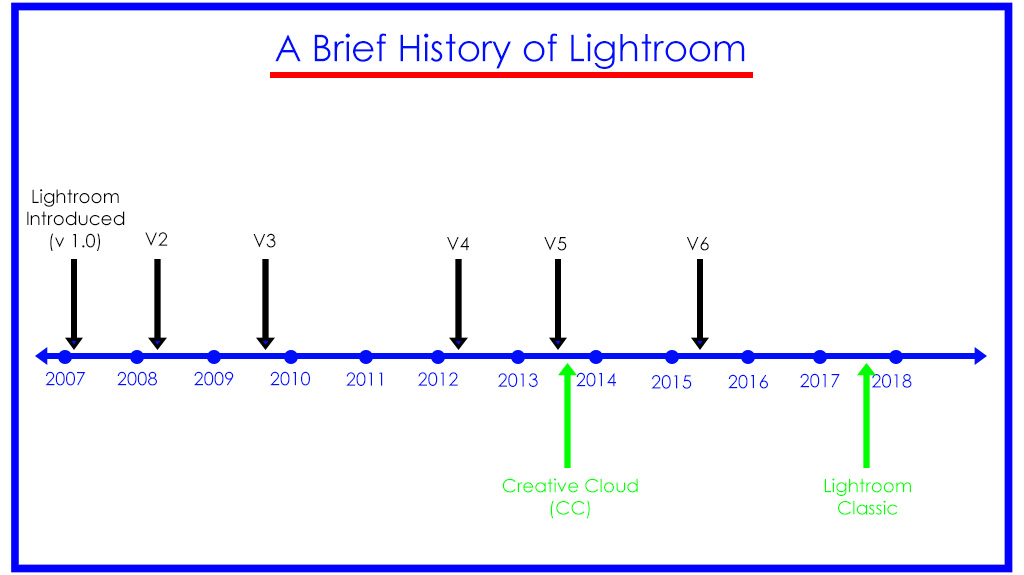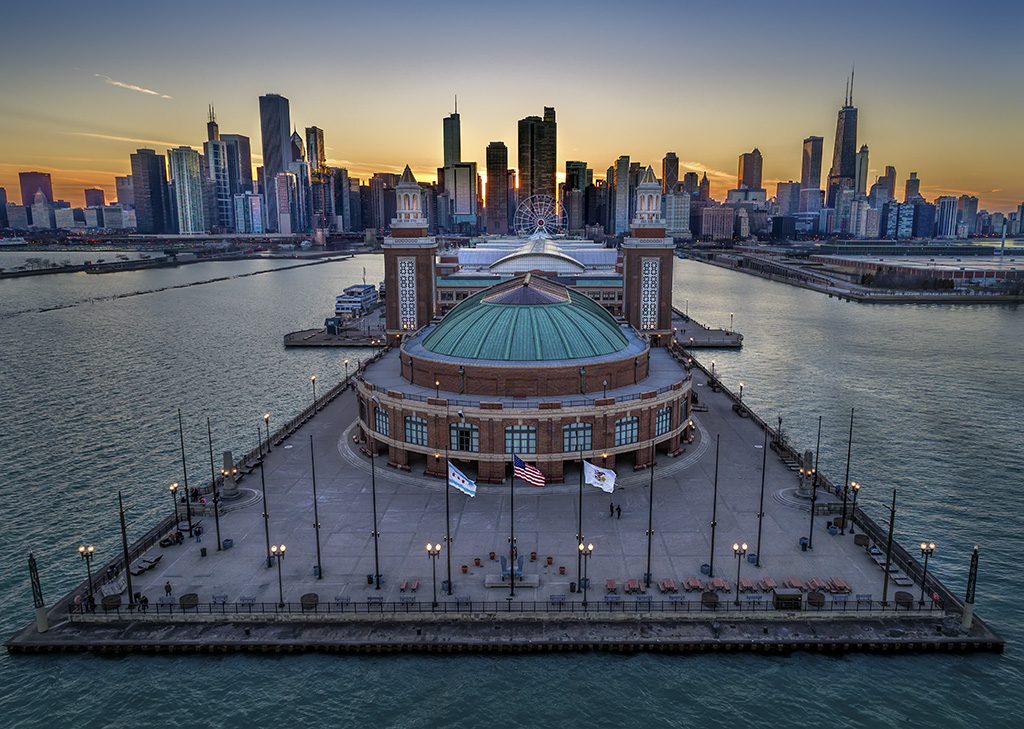
One question you might have as you start your photographic journey is which photo editing software you should get. For a long time now, Adobe has been at the top of the chain, with Photoshop and Lightroom dominating the market. So complete was Adobe’s dominance, that others companies were content to market their software as mere add-ons (or plug-ins) to Adobe’s products. Apple actually fled the market and discontinued its Aperture software altogether.
The question has taken on renewed vigor recently, however, as additional companies are now offering their own photo editing platforms, and there are a few additional entries into the market. In addition, some people are dissatisfied with Adobe’s latest pricing model, which involves a monthly charge for use of the software rather than purchasing it outright. As a result, you’ll hear a lot more people talking about this question.
Which Photo Editing Software? Lightroom
Let’s get right to the answer first, and then we’ll backfill with additional information for those that want it. The answer (at least for me) is that you should get Lightroom. It is very robust, easy to learn, and has been the industry standard for several years.
To obtain Lightroom, get the Photography Plan from Adobe, in which you get Lightroom and Photoshop for $10 a month. While you will get Photoshop as part of the deal, I recommend you start with Lightroom and get comfortable with it first. In fact, you may use nothing more than Lightroom for eternity, and that is just fine.
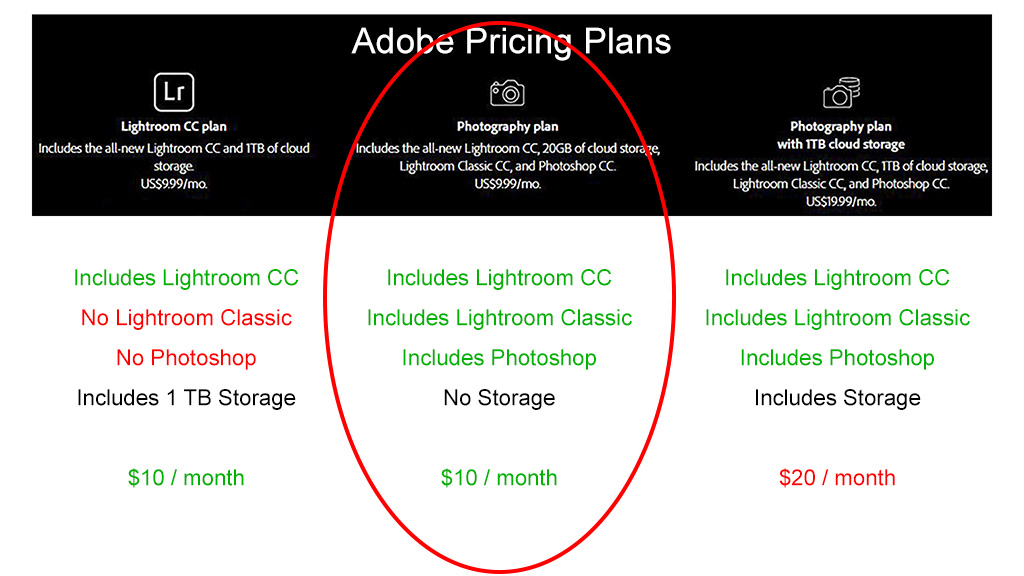
With that answer in hand, let’s go back and explain things a bit. I’m doing this in the form of a question and answer session, which I think covers all the major issues.
Why Not Start with Photoshop?
Photoshop is the most powerful photo editing software on the planet, bar none. It is an amazing tool, and I love it. But it probably took me about a year to get comfortable with it. It took me a few years to get to the point where I felt like I was proficient. At this point, I have been using it for several years and I still don’t feel like I have truly mastered it (there are very few who have). It is very non-intuitive, complicated, and difficult to learn. Therefore, I just don’t think you should start out here.
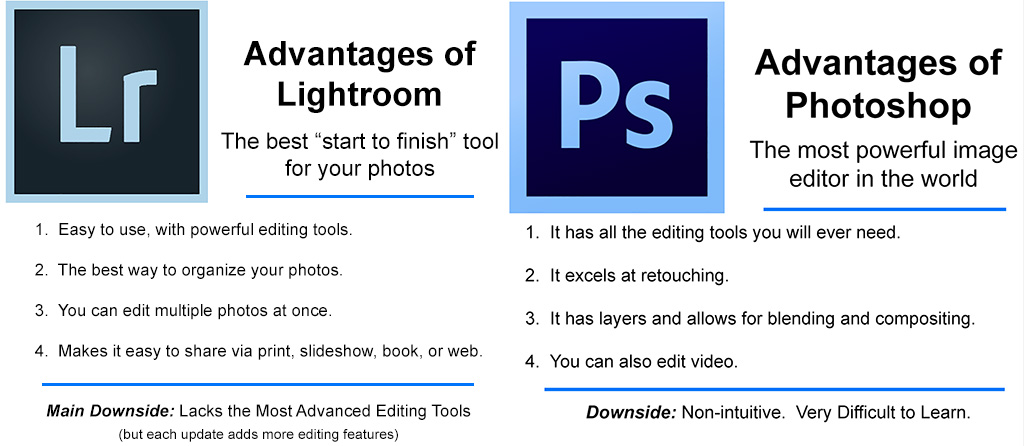
On the other hand, you can learn Lightroom in a weekend. You will find that the vast majority of the edits you want to do can be done in Lightroom. It is getting more and more common for advanced photographers to use nothing but Lightroom to edit their photos. As a result, you can get by just fine with Lightroom. In any case, if you get the Photography Plan, you’ll have Photoshop too, so you can always pop over and use it when the situation requires.
Is this What You Use?
Sort of. I actually use some of Adobe’s other applications as well, such as Premiere (for video) and InDesign (for pdfs), so it made sense for me to get the entire suite of Adobe software. I get the Adobe Creative Suite, which sets me back $50 a month. Of course, I get Lightroom and Photoshop as part of that package. But if I stopped teaching photography, such that I no longer needed Premiere and InDesign, I’d revert to the Photography Plan. Assuming you are just using Adobe products for photography, the Photography Plan is all you need. There is no point in you spending the extra $40 a month.
But I Don’t Want to Pay Monthly. Can I Buy Lightroom?
As I type this, it is still possible to purchase Lightroom outright. But its days are numbered.
The latest standalone version is Lightroom 6 (I could not find it on Adobe’s website, but it is possible that it is tucked away somewhere – the last time I looked I found it but only after searching for a while). In any event, you can buy Lightroom 6 from other retailers. It typically costs about $150, although you can often find it a little cheaper. If you go this route, however, be warned. Adobe has already announced that it will be doing no further updates to this software. That means if you get a new camera, it will not be supported.
Can I Buy Photoshop?
Not really, but you do have two options, neither of which is ideal. The first option is to buy Photoshop Elements. This is a scaled back and more intuitive version of Photoshop. It isn’t as powerful as Photoshop, but if you don’t need some of Photoshop’s most advanced features, it will be fine for you. You can get this new from Adobe for $70.
You simply cannot buy the current version of full Photoshop (as mentioned previously, you can only rent it). But you can buy old versions online. The last version of Photoshop that was offered for sale was Photoshop CS6. You will find copies of this for sale online. Be warned that this is a few years old now, and if you have a relatively new camera it will likely not be supported. It hasn’t been updated in a few years. This approach is fraught with potential problems, and I do not recommend it, but if you are dead set on getting Photoshop without the monthly subscription, this is your only option.
How Good Are the Other Non-Adobe Products that are Available?
By all accounts, the other products that are available are very good. I’m not trying to steer you away from any of them, if you are inclined in one of those directions. I have worked some in Luminar and wrote about that in this article.
I have only dabbled with the other products. If you are interested in full-scale comparisons of all the other software that is available, others have already done it. For example, you can check out Darlene Hildebrandt’s series where she tests all the software available here (for part 1) or here (for part 2).
What’s Your Connection to Adobe?
I have no affiliation with Adobe. I get nothing from them, I don’t know anyone that works for Adobe, and I have never even been contacted by them. None of the links you will see here are affiliate links.
All that said, am I an Adobe apologist? Maybe. I like Lightroom and Photoshop (and Premiere and InDesign for that matter). I have been recommending Lightroom and Photoshop for years, so perhaps I’m just locked in at this point. I don’t even mind the pricing model, and in fact I jumped on it as soon as it was available because the cost to buy Photoshop was so high ($750 to buy and then the upgrades were about $300). I have been using these products a long time, so perhaps an ingrained desire not to learn other software is clouding my judgment. I don’t think so, because I think that if something better was available I would instantly view it as a way to make my pictures stand out a little bit more (plus I actually have some of these other software applications and use them occasionally), but I acknowledge that possibility.
Which Version of Lightroom? Lightroom Classic or CC?
In late 2017, Adobe split Lightroom into two different applications. They created a more streamlined version of Lightroom that is best suited for mobile devices and cloud storage and called it Lightroom CC. Adobe updated the prior version of Lightroom and called it Lightroom Classic. So now we have Lightroom CC and Lightroom Classic. You may be confused about which one to get and use.
When it comes to which one to get, it is sort of a false choice, at least if you get the Photography Plan I recommended earlier. In that plan, you get both. No need to worry. If you get a different plan, then you will have to choose. Adobe offers a plan with cloud storage and Lightroom CC only for $10 a month, and another plan with cloud storage and both Lightroom CC and Classic for $20 a month (see the chart at the top of this page). Honestly, I think these other plans for people who take their pictures with cell phones, and not for serious photographers, so I just don’t think they are for you.
As just mentioned, under the Photography Plan, you get both Lightroom CC and Classic. So which one should you actually use? Use Lightroom Classic. It is much more robust. Think of Lightroom CC as Lightroom Lite at this point. In the future, Adobe may add more features to Lightroom CC, but right now it is lacking a lot of the features you will find in Lightroom Classic.
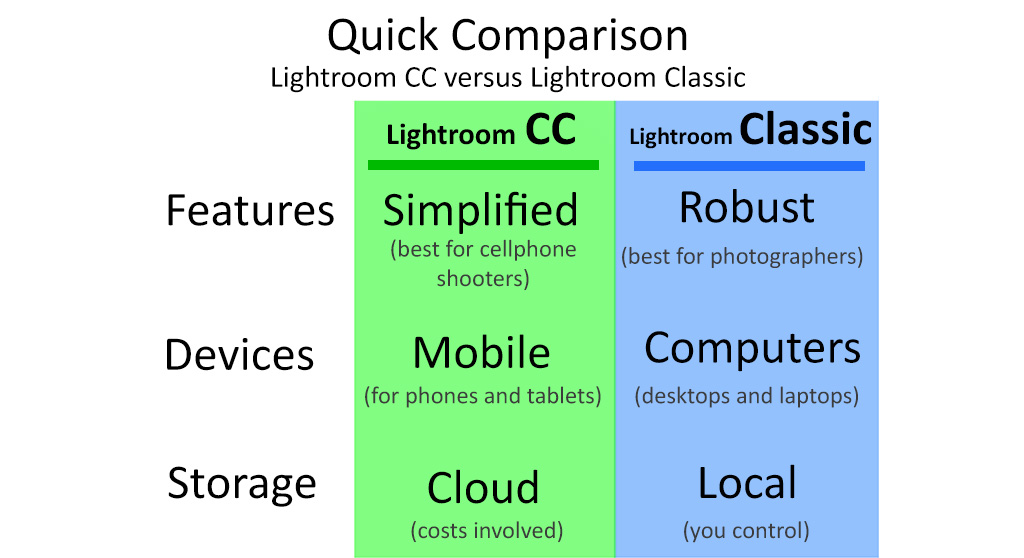
If you want to know more about the differences between Lightroom CC and Lightroom Classic, here is an article I wrote on the differences.
Is Lightroom Classic Going Away?
Nobody knows. I’m not sure Adobe knows.
But here’s the deal. When Adobe put the Classic designation on the prior version of Lightroom (even though they updated it at the same time), that was viewed as the kiss of death by a lot of people. Classic means old. Old means obsolete. Therefore, Lightroom Classic must be headed for the junkpile.
It could happen. Adobe might put all its resources into updating Lightroom CC. While Lightroom CC isn’t nearly as robust as Lightroom Classic, perhaps it gets there in the future. At that point, there is really no need to have two different versions of Lightroom. Under that scenario, Lightroom Classic goes away.
But it is not something we need to worry about when deciding which photo editing software to choose. First of all, we don’t know if things will go down that way. And even if that does happen, by then Lightroom CC will presumably have been updated considerably, such that it won’t constitute a significant step backwards.
Why All These Different Names and Numbers for Lightroom?
It is just a function of how Lightroom was developed. In the beginning, there was just Lightroom. As new versions came out, they just got a new number. So we had Lightroom 2, 3, 4, 5, and 6. It is quite tidy and understandable.
But then in 2013, Adobe started the subscription model. Everything started getting called CC, which stands for Creative Cloud. At the time, Lightroom was exempted from this model, so you could still buy Lightroom 6 or go to the subscription model, which was called Lightroom CC. During this timeframe, you had either Lightroom 6 or Lightroom CC.
This was the state of affairs until late 2017, when Adobe announced that there would be two versions of Lightroom (that is also when it announced it was discontinuing support for Lightroom 6 and there would be no future versions for sale). Adobe put the CC designation on the mobile-friendly, cloud-based version of Lightroom. Adobe called the other version Classic, as noted above. So now you still had Lightroom 6 lingering about, and you also had Lightroom CC and Lightroom Classic.
